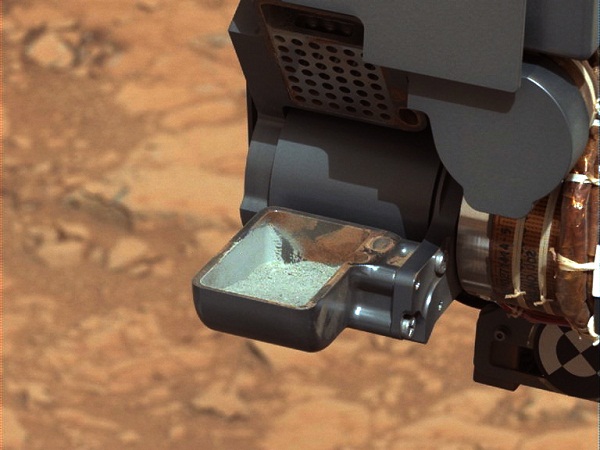
This undated image provided by NASA shows powdered rock in the scoop of the Mars rover Curiosity. The six-wheel rover collected the sample after drilling into a Martian rock. The next step is to transfer a portion to its onboard laboratories for analysis. Curiosity landed in August 2012 to study whether the environment was hospitable for microbes. AP/NASA
LOS ANGELES — Fresh off drilling into a rock for the first time, the Mars rover Curiosity is prepping for the next step: dissecting the pulverized rock to determine what it’s made of.
Images beamed back to Earth on Wednesday showed a tablespoon of gray powder in Curiosity’s scoop, giving scientists their first glimpse of the sample collected during the drilling nearly two weeks ago. Over the next several days, Curiosity will sieve the powder and deliver a pinch to its onboard laboratories for analysis.
The Martian landscape is stained orange-red by iron-rich dust from the surface that is blown around in the atmosphere. That the drilled rock is gray underneath signals that it probably did not undergo certain chemical changes through surface exposure, scientists said, and it’s a good starting point in Curiosity’s quest to determine whether the environment was ever favorable for microbes.
“It’s pretty exciting to us that you just sort of brush beneath this surface veneer … and the rocks are a completely different color,” said mission scientist Joel Hurowitz at the NASA Jet Propulsion Laboratory.
The car-size Curiosity landed in an ancient crater near the Martian equator last summer after a harrowing plunge through the thin atmosphere. Soon after landing, the six-wheel rover drove to a waypoint where it checked out its high-tech tools.
The drill was last to be tested. Engineers previously said it was the hardest engineering task since the landing, which relied on never-before-tried tricks to lower the rover from its spacecraft with cables.
Depending on how the rock analysis goes, the team may decide to drill again or start heading toward Mount Sharp, the rover’s ultimate destination where images from space reveal intriguing layers at the base.
The trip to Mount Sharp has been delayed several times mainly because the instrument check-out has taken longer than expected.